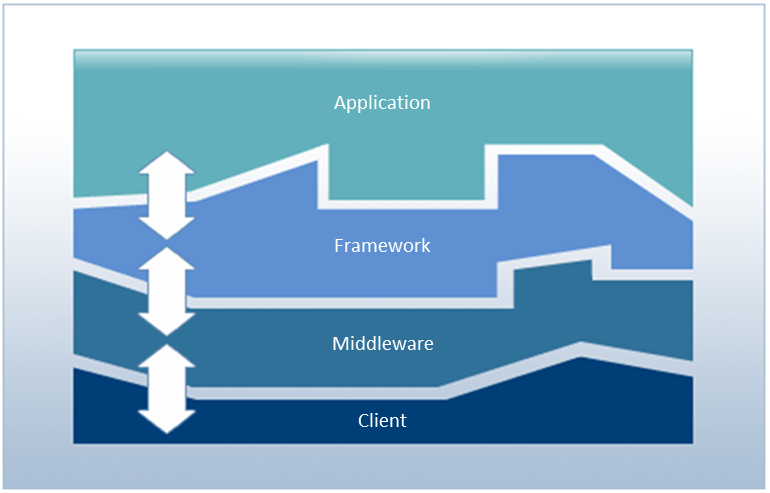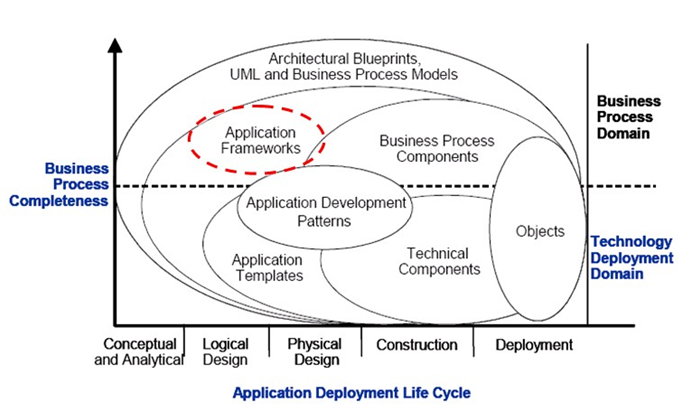Table of Contents
This chapter describes the concept, components, and benefits of business frameworks.
Modern enterprises need appropriate changes to quickly respond to rapidly changing business and computing environments. Companies have come to realize that they need to increase IT competitiveness as a strategy to survive in limitless competition. Therefore, they needed changes in the IT environment for process improvement, standard interfaces, and business as modules. A representative example of the changes is a change in application architecture.
Changes in Application Architecture
Application architecture is changing from a structure where system-related processing and all application parts need to be manually developed to an N-tier structure where only business logic needs to be implemented. That is, an application only processes business logic, and other functions are processed by middleware or frameworks.
Such changes in application architecture ensure an optimized application development, execution, and operation. They also standardized interfaces with other systems and made application development and debugging easier.
Frameworks
In the changed architecture shown in [Figure 1.1], a framework consists of well-defined application architecture and standardized components and tools.
For example, ProFrame provides the following application architecture, components, and tools.
-
RunTime engine
-
Core system architecture, common components
-
-
Integrated server
-
Meta management
-
Development tools and server API for support
-
-
Integrated development GUI tools
-
Studio, ProMapper, DBIO, EMB Designer, etc.
These tools help improve service and application development productivity and maintenance.
-
Enterprises need to adopt a framework with the following reasons.
| Criteria | Necessity |
|---|---|
| Business requirements | Development using a framework allows to flexibly respond to various customer requirements and provide best practice with framework packages. |
| Costs | Only functional modules such as system and application common modules can be adopted. Since only application modules can be internally developed, human resources and cost for development can be reduced. Additional cost can also be reduced through maintenance based on enhanced standards and flexible architecture platforms. |
| Development productivity | Development productivity can be maximized through high reusability and easy application implementation. |
| New technology acceptance | Reliability for system and application logic can be guaranteed. The 3-tier structure allows to flexibly respond to IT technology changes such as SOA. |
| Risks | By selectively adopting framework modules and in-house development, software development risks can be reduced and optimized customization can be performed. |
If an enterprise adopt a framework, optimized and effective application development is possible, compared to SI development or package adoption. In addition, it can be provided with high-performance, reliable, and flexible platforms. That is, enterprises need to adopt a proven framework with high-performance and reliable architecture to flexibly respond to new and various customer requirements.
TmaxSoft's Business Framework
For enterprises' entire systems and their business competitiveness, TmaxSoft presents 4 framework areas to which SOA idea applies. The 4 framework areas are UI, interface, business, and data frameworks. Among them, the business framework processes business logic for an enterprise's applications and consists of application framework, business rule, and product factory. It is a core area for implementing "service-based integrated system". It guarantees high performance, flexibility, and reliability for an enterprise's systems.
The following describes about the business framework.
TmaxSoft's business framework consists of the following:
-
ProFrame: application framework
-
Tmax ProRule® (hereafter ProRule): business rule
-
Tmax ProFactory® (hereafter ProFactory): product factory solution
The application framework is a semi-complete application used to develop specific applications. It allows to consistently and rapidly develop channels and services because IT and enterprise business environments quickly change. It also allows to resolve issues that occur when integrating with various software products such as WAS, WS, TP-monitor, MCI, and DBMS. In addition, it guarantees high development productivity, stable service, and efficient operation and management.
TmaxSoft's Application Framework
TmaxSoft provides ProFrame as an application framework. ProFrame is developed based on Enterprise Module Bus (EMB). It creates service or application modules that process jobs and registers them to a module pool in order to reconfigure a new service or application flow by using them. It reuses existing service and application modules for codeless development, which enables implementing a service-based architecture.
ProFrame provides a system with high integration, scalability, and development productivity for enterprises. It allows to develop only applications in an application area for an application system. Since the applications are developed with a consistent application structure, they can be easily managed.
Enterprise business is rapidly changing in an IT environment. In such an environment, applications are becoming N-layered for agility and easy maintenance. As a part of it, Business Rule Management System (BRMS) has emerged. BRMS is an improved way to freely express business rules.
Business rules are the knowledge, rules, and ways to perform or process work. For example, they are expressed as "in some cases, it is good to do this." and "it is calculated with what and what."
With the use of BRMS, companies no longer have to write hard code for the areas where business changes are frequent and require quick business application, and they can build a system based on rules. The rule-based systems provide a flexible system for business changes and shorten the period of developing new services or products.
However, since the components of products are still managed with parameters, there are still disadvantages of increasing database I/O and lowering capacity for new products. In addition, there is also the inconvenience of separately modeling the components and rules of the products because the tools are not integrated.
TmaxSoft's Business Rule
TmaxSoft ProRule is a BRMS-based development method that allows to easily improve development productivity by using GUI tools in the design and development steps. In addition, in the actual operation step, the system performance can be guaranteed by providing the rule module call structure.
ProRule implements a policy-based system that can rapidly respond to enterprise business environments by providing various features such as reliability, performance, visibility, and convenience.
As the relationship between business and IT grows closer and customer needs diversify, companies need a product development system that can respond quickly and flexibly to these changes. Developing hybrid products that can meet these customer needs and implementing time to market (TTM) by innovative improvement of IT that is agile to product needs have become important. Time to market (TTM) refers to the time or period it takes to manufacture a product and provide it on the market. To meet the needs and environments of these companies, a new product development system called product factory appeared.
Product factory refers to a system that supports systemic functions in the company-wide business area of product planning, development, operation, and evaluation, develops product shape, and provides product information to the business system.
The product development system so far has been constructed in the form of implementing the formal attributes or atypical rules of products as parameters or rules, respectively. However, the product factory solution manages both formal and unstructured information of products to accurately define the shape and reflect it in the system. As a result, the product factory system can express convergence/composite products and various types of products as an integrated product management solution method, and enables product development for product time to market.
TmaxSoft's Product Factory
Tmax ProFactory can define products with scalability, flexibility, and high performance, and it provide easy product management and operation. In other words, it can quickly and easily develop any type of complex product to be provided on the market in the future without slowing down the system and reducing the workload. In addition, it is an advanced product factory that supports the definition of various new products by managing the structure, attributes, and rules of products and services from an object-oriented perspective and combining them.
As described previously, a business framework has the following components as a solution for business implementation and operation.
-
Application framework
Configures and supports an enterprise's application architecture and provides easy development, operation, and maintenance through application standardization. In addition, by supporting the core architecture area, it supports the best practices for areas that are difficult for enterprises to design.
-
Business rule
Allows to easily apply complex logic for frequently-changing applications in the business of the enterprise. It also allows enterprises to directly manage and apply critical applications for rapid business application.
-
Product factory
Facilitates the verification of a product to launch and reduces the time that takes to provide services for many products. It also allows to timely provide products and services to customers through a product management system for the entire product launch process (planning, development, operation, and evaluation).
The components of each application framework are integrated with the business framework and managed to support rapid and agile development, deployment, and operation.

